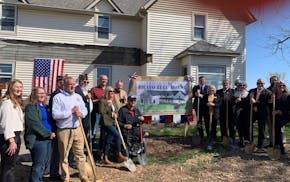For a quarter-century, Beverley Miller has guided the Minnesota Valley Transit Authority (MVTA) as the organization's first — and only — executive director. During her tenure, the south-of-the-river bus service has seen annual ridership nearly quadruple. In 2014, Miller led the MVTA through a merger with the cities of Prior Lake and Shakopee to become an agency serving seven cities.
Miller will retire this week and her replacement hasn't yet been named. She shared some of her parting thoughts in this edited conversation.
Q: You've spent your entire career working in transit. Why do you like it?
A: Well, I believe in it. I believe people need alternatives. Not everybody has access to a car all the time.
Q: What have been the biggest changes in 25 years of transit and MVTA?
A: When we started, I think there was the myth that people in suburban areas didn't want to use transit, or there wasn't a need. When I came, the cities got behind the initiative and here we are today, 25 years later, with nearly 10 times the number of trips [each day] and just under 3 million rides annually. I think it's part of the culture change as well, where young people want to stay mobile but they don't necessarily want to drive. Some ride the bus or the train, or they bicycle.
Q: As you look back, has anything MVTA has done been especially challenging or controversial?
A: I think 25 years from now, funding will still be a challenge. Putting together the park-and-rides — those are always challenging, too. In the first few years, there was a real need. It became apparent right away in Burnsville and Apple Valley. People were parking on streets and side roads, and the neighbors were mad because they didn't want a car parked in front of their house. We had to do something, so we began creating park-and-rides.
Q: What future directions do you see for MVTA?
A: Savage has always been one of my MVTA cities, and this last year Prior Lake and Shakopee joined us. So we have growth potential in Scott County and through the new service that we're going to be providing, the station-to-station service in the Hwy. 169 corridor. We got money through the Legislature last year so that's a big initiative. We've been focused on the suburban-to-downtown market. With all the growth and jobs in suburban areas, I think the next real emphasis will be on suburban-to-suburban corridors.
Q: Will MVTA expand to other counties?
A: In its strategic plan, MVTA has said it wants to be the [transit] provider south of the river, so I can see that, yes. For example, these folks [from Rice County, including the county administrator] came to visit us. They're just starting to explore what they need. There's just more talk of transportation in general. From the Mayo Clinic in Rochester, and Washington County, the Red Rock corridor, everybody has started to really identify with, how are we going to move people around and meet economic growth?
Q: How will MVTA work with Metro Transit so suburbanites can access the broader transit network in the Twin Cities?
A: I think MVTA is looking for opportunities to make connections outside major hubs such as the Mall of America. We're looking at creating some other opportunities … for these hubs, more to the western side. We hear people don't want to go all the way downtown and transfer to go back out to a suburb. We're starting to look at the Hwy. 169 corridor, what services others provide there and how we can link that service with unserved destinations.
Erin Adler • 952-746-3283

Hennepin County Attorney inks contract with D.C. law firm to prosecute trooper Londregan case

Defense attorneys in Feeding Our Future trial cast doubt on FBI's meal fraud investigation

Protesters hold dueling Gaza rallies at University of Minnesota

Overdose deaths spike after incarceration, but Minnesota jails lack treatment

